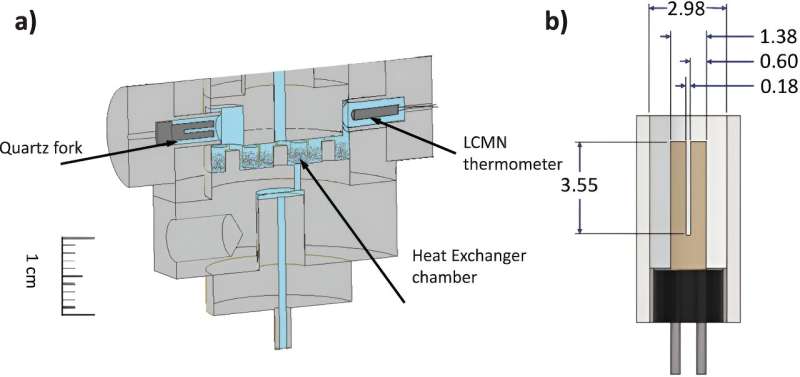This article has been reviewed according to Science X's editorial process and policies. Editors have highlighted the following attributes while ensuring the content's credibility:
fact-checked
peer-reviewed publication
trusted source
proofread
In helium-three, superfluid particles pair 'like a dance in space'

Picture a nanoscale dance floor full of independently moving particles. When things really start to heat up—or, in this case, cool down—particles partner off, but on opposite sides of the space, "dancing" in synch as if telepathically.
In the ultra-pure isotope helium-three (3He), this dance starts at a very specific, very low temperature, when it converts into the superfluid phase (where its superfluid component has no viscosity and thus flows without friction) through a mechanism called pairing. Pairs of particles form over huge atomic distances in three dimensions.
"It's something like a dance in space," said Jeevak Parpia, professor of physics in the College of Arts and Sciences (A&S). "The effect of this pairing, called a 'fluctuation,' is to scatter other non-paired partners and disrupt the overall transport of momentum."
These superfluid fluctuation effects were predicted almost 50 years ago, but no one had the instrumentation to see it; now, enabled by a custom thermometer that is accurate at super-low temperatures and sensitive enough to capture this subtle effect, Cornell researchers have observed the phenomenon in experiments—possibly gaining new insight for quantum computing and the physics of the early universe.
"Observation of Suppressed Viscosity in the Normal State of 3He due to Superfluid Fluctuations" was published Sept. 20 in Nature Communications. Parpia led the study, and research was primarily conducted by postdoctoral researcher Yefan Tian and doctoral student Rakin Baten. Eric Smith, Ph.D. '72, was an essential team member and Erich Mueller, professor of physics (A&S), provided theoretical support.
To observe the minute changes of superfluid fluctuations at ultralow temperatures, the researchers used a tiny thermometer, 1.25 mm in diameter and 1.25 mm long, a homemade device they started to build during the COVID pandemic and are still refining.
"The low noise is essential," Parpia said. "After all, we are looking for a small effect and if the temperature is 'blurry' or noisy then this small upturn [the sign of a superfluid fluctuation] is going to buried in the noise."
As the only "quantum fluid," helium is unique, Parpia said. All other elements, when cooled down, undergo phase transitions from liquid to solid; but while helium does change from a gas to the liquid state, the atoms don't solidify unless a great deal of pressure is applied. This is because each atom's mass is so small that the motion of the atoms is bigger than the separation of atoms. Even near absolute zero, helium atom components called quasiparticles (also known as excitations) are moving quickly and colliding with each other.
"Fluctuations are signaling that a change is coming, just like a wind gust can signal a storm," Parpia said. "They occur just above the actual superfluid transition and disrupt the transfer of information. That's because the quasiparticles pair up and have a very short lifetime, less than a millionth of a second even a few micro-degrees above the superfluid transition."
A similar pairing mechanism also occurs in superconductors, which conduct charge (electricity) without resistance.
"Once a current is established in a superconductor, for example in a loop, it would flow forever," Parpia said. "Superfluids are superconductors on steroids. The atoms, not just the electrons, flow without resistance. But unlike electronic superconductors where disorder is almost ubiquitous—it's very hard to make a superconductor without defects, or 'dirt,' if you will—helium-three is ultrapure. So it is the best model system to study some exotic properties."
Excitations in helium-three may be useful as a platform for quantum computation, Mueller said. A strategy known as "topological quantum computation" relies on the fact that pairs of excitations in certain exotic superconductors, such as those seen in helium-three, are theorized to act as quantum bits (qubits).
"While it has been challenging to find (or create) superconducting devices with the right types of excitations, there are predictions that helium-three could work. The first step is showing that helium-three has these 'topological' excitations," he said. "Characterizing the superfluid fluctuations is an important step towards investigating this possibility."
There are also suggestions that phase transitions in helium-three are ideal model systems that emulate the physics of the early universe, Parpia said, when energy first started to be differentiated into different forms and different fundamental forces emerged.
"Because the physics of helium is one of extreme purity and ultra-low temperatures, paradoxically that's what makes it a good model for this ultra-high energy inflationary 'epoch' in the early universe," he said. "How neat would it be if we were able to understand some aspect of the early universe in the lab!"
More information: Rakin N. Baten et al, Observation of suppressed viscosity in the normal state of 3He due to superfluid fluctuations, Nature Communications (2023). DOI: 10.1038/s41467-023-41422-3
Journal information: Nature Communications
Provided by Cornell University




















